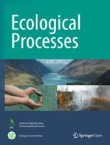Ver ítem
- xmlui.general.dspace_homeCentros Regionales y EEAsCentro Regional Patagonia SurEEA Santa CruzArtículos científicosxmlui.ArtifactBrowser.ItemViewer.trail
- Inicio
- Centros Regionales y EEAs
- Centro Regional Patagonia Sur
- EEA Santa Cruz
- Artículos científicos
- Ver ítem
Quality evaluation of Nothofagus pumilio seeds linked to forest management and climatic events
Resumen
Forest ecosystems undergo significant transformations due to harvesting and climate fluctuations, emphasizing the critical role of seeding in natural regeneration and long‑term structural preservation. Climate change further amplifies these dynamics, affecting phenology across species and regions. In Tierra del Fuego (Argentina), Nothofagus pumilio (lenga) forests represent the most important timber resource, and it is managed through different
[ver mas...]
Forest ecosystems undergo significant transformations due to harvesting and climate fluctuations, emphasizing the critical role of seeding in natural regeneration and long‑term structural preservation. Climate change further amplifies these dynamics, affecting phenology across species and regions. In Tierra del Fuego (Argentina), Nothofagus pumilio (lenga) forests represent the most important timber resource, and it is managed through different silvicultural strategies. This species demonstrates notable post‑disturbance regeneration, yet seed fall exhibits significant variability, leading to variations in seed quality (e.g., viability). This study aims to assess fluctuations in N. pumilio seed quality, determine how it varies concerning forest management strategies, annual productivity, and the cooccurrence of climatic phenomena including El Niño‑Southern Oscillation (ENSO) and the Southern Annular Mode (SAM). Viable seeds represented 18.4% of the total, notably higher in unharvested than in managed areas. Con‑
versely, empty seeds were more prevalent in harvested areas (> 75%). Seed quality exhibited significant differences across silvicultural treatments, except for insect‑predated seeds, which had similar proportions across all areas, though dispersed retention showed higher predation. When considering years with varying production levels, high‑production years favoured full and viable seeds, particularly in unharvested forests and aggregated retention, while low‑production years saw reduced viability across all treatments. Quadratic models revealed that viability increased with seed production, where unharvested forests achieved the highest values. Climate variability influenced seed proportions, where ENSO+/SAM+ promoting more full and viable seeds, while ENSO–/SAM+ favoured non‑predated seeds, especially in unharvested stands. Seed quality varies among treatments and years with different levels of seeding. Variations in seed quality, linked to climatic events, influence seed viability. Seed quality plays a critical role in forest regeneration, ensuring a seedling bank for harvested stands to face climate variability. These findings are relevant for forest management and ecosystem services, considering the increasing climate variability and extreme events. Understanding these influ‑
ences is crucial for Nothofagus pumilio forests’ sustainability and global forest adaptation strategies.
[Cerrar]

Autor
Rodríguez‑Souilla, Julián;
Chaves, Jimena Elizabeth;
Lencinas, María Vanessa;
Cellini, Juan Manuel;
Roig Junent, Fidel Alejandro;
Peri, Pablo Luis;
Martínez Pastur, Guillermo José;
Fuente
Ecological Processes 13 : 7 (2024)
Fecha
2024-01-23
Editorial
Springer Nature
ISSN
2192-1709 (electronic)
Formato
pdf
Tipo de documento
artículo
Palabras Claves
Derechos de acceso
Abierto
 Excepto donde se diga explicitamente, este item se publica bajo la siguiente descripción: Creative Commons Attribution-NonCommercial-ShareAlike 2.5 Unported (CC BY-NC-SA 2.5)
Excepto donde se diga explicitamente, este item se publica bajo la siguiente descripción: Creative Commons Attribution-NonCommercial-ShareAlike 2.5 Unported (CC BY-NC-SA 2.5)


